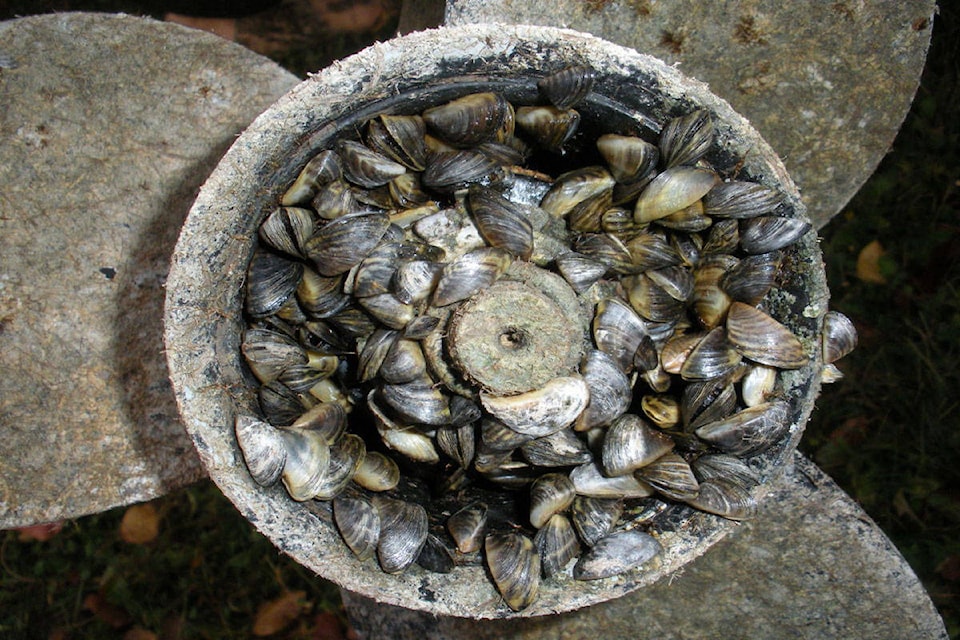The Okanagan Basin Water Board is still feeling flustered about why efforts to prevent or respond to an invasive mussel infestation in B.C. is not falling on attentive ears.
Board officials were from the Lower Mainland in Ottawa six months ago to raise concerns about the devastating economic impact the appearance of the mussels would bring.
As such meetings tend to go, the initial response was positive and a response was promised, although OBWB director Doug Findlater, West ��������’s mayor and a vocal advocate for expansion of the invasive mussel prevention program, said he felt the MP wasn’t up to speed on the issue.
But having heard no further feedback since, the water board has decided to send another letter to Ottawa asking for the promised response to their funding request.
Sue McKortoff, an OBWB director and mayor of Osoyoos, commented that 19 states in the U.S. have petitioned the U.S. Congress for funding support related to invasive mussel control issues, and the Great Lakes in Ontario have already been lost to the mussel plague.
“This isn’t an issue that should be a surprise to anyone,” McKortoff said about the potential federal Liberal government response.
OBWB chair Tracy Gray, a �������� city councillor, cited equal dismay with the province regarding a 70-page mussel response plan unveiled in February 2015. Only three pages were related to what to do if the mussels show up in a B.C. waterway and the report hasn’t been updated since then.
“There is a lot of background about the mussel problem in that report but if they are found somewhere, what is the plan?” Gray questioned.
Related:
The need for a response plan was one lesson learned by Montana environment officials after a positive test for mussels was detected in August 2016 and confirmed three months later in two of that state’s water reservoirs.
That positive detection sparked the immediate creation of an emergency response command centre and heightened boat quarantine measures while search efforts were intensified for further mussel detections.
One of the lessons learned, according to Montana officials, is that an emergency response plan should be detailed in structure and affected government agency responsibilities clearly defined before a mussel infestation occurs, not after one is detected.
Corinne Jackson, communications director for the OBWB, said a conference call Oct. 26 with 12 agencies in B.C. conducting invasive species outreach initiatives revealed that aquatic invasive, let alone zebra or quagga mussels, were not a high priority for groups in the Metro Vancouver area or northwest region of the province.
Citing the lack of a detailed emergency response plan, an apparent lack of interest, particularly down south in proactive invasive mussel detection efforts, and statistics showing the percentage of boats caught carrying invasive mussels at inspection stations being the same for the last two years, OBWB operatons and grants manager James Littley said the problem is not being “treated like the potential natural disaster that it is.”
Related:
The province reports that of the 35,000 watercraft inspected this year as of Oct. 16, 24 were confirmed to have adult invasive mussels on board, with seven of them destined for the Okanagan and 11 for the Lower Mainland.
But while the Fraser River or area lakes such as Harrison Lake would be equally susceptible to an invasive mussel infestation, other board directors were puzzled their counterparts on the coast for the Fraser Basin Council don’t share in their concern.
The economic impact of invasive mussels in lost revenue and added maintenance to aquatic infrastructure has been estimated to exceed $42 million per year in the Okanagan alone, and $500 million annually in the Pacific Northwest, the last region in North America yet to deal with the invading mussels.
The annual cost on the Great Lakes to control zebra mussels in water intakes alone is $250 million.
Mussel infestations negatively affect municipal water, hydro power and agricultural irrigation systems by clogging water intakes and distribution pipes, and fouling aquatic infrastructure such as bridges and marinas.
The sharp shells litter beaches around waterways, increasing the volume of aquatic weeds along lake shorelines and creating toxic algae blooms.
To report a typo, email: edit@kelownacapnews.com.
<>
barry.gerding@blackpress.ca
Like us on and follow us on .



